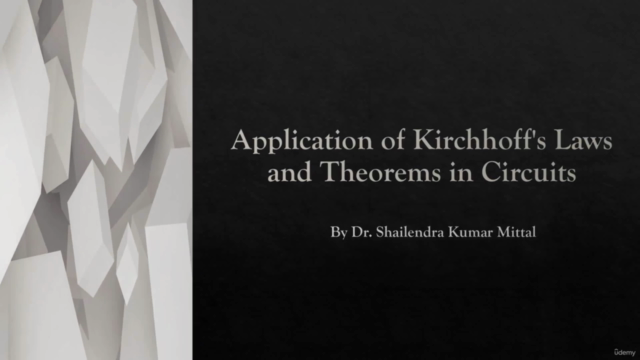Electrical, Electronics and Two Port Network Analysis

Why take this course?
🎓 Course Title: Electrical, Electronics and Two Port Network Analysis
Course Headline: Mastering Fundamentals of DC Circuit Analysis Through Numericals
Course Description:
Objectives:
-
Laplace Transform mastery:
- Calculate the Laplace transform of common functions using the definition and reference tables.
- Apply Laplace transformation to circuits with non-zero initial conditions.
-
s-domain analysis:
- Analyze circuits in the s-domain for insightful behavior under sinusoidal steady-state conditions.
- Validate s-domain results using the Initial Value Theorem and Final Value Theorem.
-
Inverse Laplace Transforms:
- Transform circuit solutions back to time domain.
- Identify forced response and natural response components within the time-domain solution.
-
Resonant Circuits:
- Understand the concept of Series Resonant Circuits and calculate the resonant frequency.
- Familiarize with terms like Bandwidth and Quality factor and their significance.
- Analyze how the Quality Factor impacts the Frequency Response in Series or Parallel Resonant Circuits.
-
Two Port Networks:
- Grasp the fundamentals of Two-Port networks and their functions within circuit analysis.
- Compare z-Parameter, y-Parameter, ABCD-Parameter, and Hybrid-Parameter representations.
- Investigate and analyze the behavior of Two-Port networks under different conditions.
Additional Resources:
- Downloadable document for each topic to enhance understanding and provide reference materials.
- Interactive quizzes at the end of the course to test your comprehension of the topics covered.
Intended Outcomes:
Upon completion of this course, students should be equipped to:
-
Engineering Application:
- Apply mathematical, scientific, and engineering principles to analyze and design electrical circuits effectively.
-
Problem Solving:
- Identify, formulate, and solve problems related to Circuits and Systems with confidence.
-
Critical Thinking:
- Analyze the validity and authenticity of solutions derived from circuit analysis.
-
Network Understanding:
- Differentiate between One Port and Two Port network devices, understanding their distinct roles in electrical engineering.
-
Parameter Calculation:
- Compute two-port network parameters such as z, y, ABCD, and Hybrid Parameters for various networks.
-
Network Simplification:
- Simplify complex networks by utilizing fundamental two-port network parameters like Cascade, Parallel configurations.
-
Function Analysis:
- Determine driving point and transfer functions of Two Port networks.
-
Stability and Transfer Functions:
- Obtain transfer functions for circuits and assess stability using the poles of the transfer function.
-
Frequency Response Analysis:
- Analyze frequency responses in circuits, correlating time-domain and frequency-domain behaviors.
-
Resonant Circuit Characteristics:
- Calculate voltage across capacitor, inductor, and resistor at resonance for series-resonant circuits.
- Bandwidth and Quality Factor Impact:
- Determine the bandwidth of a resonant circuit and understand how the quality factor Q influences sensitivity and selectivity.
- Parallel Resonant Circuit Analysis:
- Plot impedance, total current, and output voltage versus frequency for parallel-resonant circuits.
- Source Effects:
- Describe the effect of internal resistance in a source on the selectivity of parallel-resonant circuits.
Join Dr. Shailendra Kumar Mittal on this comprehensive journey through the fundamentals of DC Circuit Analysis, where you will deepen your understanding and enhance your skills through numerical examples and practical applications. 🚀✨
Course Gallery




Loading charts...